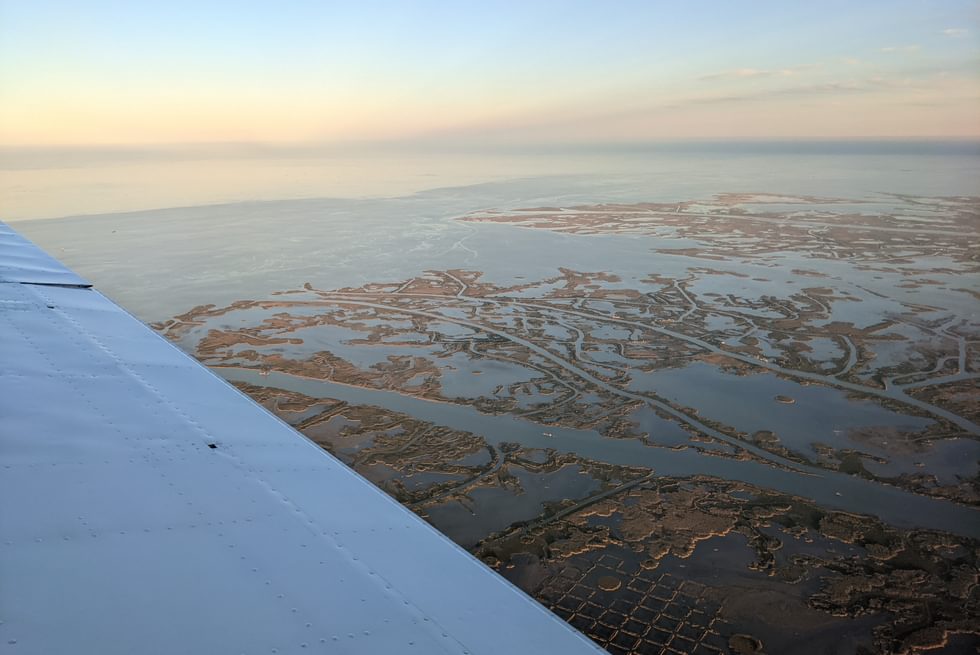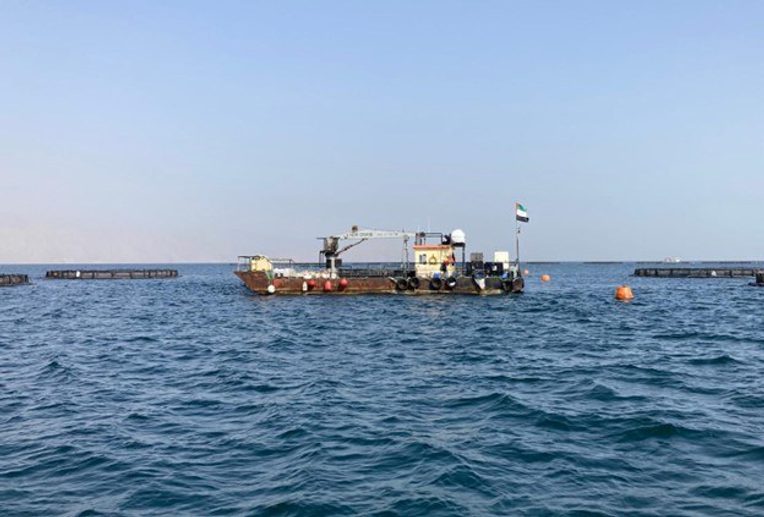Hunters and Aquaculturalists in the Gulf of Oman
From the Series: Coastal Futures
From the Series: Coastal Futures

“When was the last time you had a chicken that wasn’t farmed?” an Omani fisherman asked me last year, pointing to the fairly recent but now widespread practice of industrial chicken farming in the region. “People were resistant to the idea [of chicken-farming] in the 90s when they introduced it,” he continued, “but now 99.9 percent of chicken in the Sultanate is farmed. We need to understand that fish farming is the future whether we like it or not,” gesturing at the many skeptics of aquaculture among the ranks of fishermen.
In the thousands of years since the Neolithic Revolution, humans have transformed from a species of hunters and gatherers, who sustained ourselves from earth’s vast and untamed wilds, into a largely settled species who selected a few favorite plants and animals to bend to our will. In this long history, fish are the “last wild food” (Greenberg 2010). There are, of course, others that are culturally or nutritionally important around the world; bushmeat, deer, upland birds, or certain mushrooms all come to mind, although scholars have rightly pointed out that their harvest takes place not in virgin wilds, but on landscapes altered by humans (Tsing 2016). Even so, the hunting and gathering of these land-based creatures pales in comparison to the billions of wild fish that are extracted from the ocean each year, weighing over a hundred million tons.
Recently, however, fish’s status as a truly “wild food” has been challenged. 2014 was the first year in which humans ate more farmed than wild fish (albeit by a slim margin), and the trend continues apace. The anthropologist Marianne Elisabeth Lien has described salmon farming, one of the most popular forms of aquaculture (and most lucrative, in part because of salmon’s ubiquity), as “the most recent turn in the human history of animal domestication,” an evolutionary frontier both for humans and for fish (Lien 2015). Even so, fish farming is ancient, with a history far longer than can be told here; suffice it to say that both the Egyptians and Romans dabbled in the practice.
Today, several of the world’s most commercially important species, like salmon, catfish, tilapia, and trout, are farmed. Anxious state planners around the world have looked to aquaculture to shore up food security amidst unsteady supply chains. This is especially true in places like the Arab states of the Persian Gulf, like Oman and the United Arab Emirates, where natural constraints on domestic agriculture (i.e., scarce freshwater and arid soils) mean that many staple foods must arrive either by boat, through geostrategically precarious chokepoints, or in costly refrigerated airplanes (Woertz 2013). The appeal of farmed fish is doubly attractive to state planners because it answers another problem that increasingly vexes governments around the world: dwindling catch sizes of wild fish from the global ocean, a place which—like pine forests or “the bush”—has also been altered by humans.
Offshore farming is still in its infancy in the Gulf of Oman, but it is a rapidly growing enterprise. This Gulf, along with its neighbor, the Persian Gulf, has a complicated history of enclosure at sea – the subject of my research for the last several years. On the surface, offshore fish farms here resemble giant hoops floating atop the sea’s surface in orderly rows. Below, the “cages,” as they’re called, extend to the seafloor, ensuring that the spinning vortex of shoaling fish don’t escape. Gulls and reef herons vie for a perch on the edge of the pens. The bream and bass inside are easy targets for these and other birds; fish in a barrel.

These farms in the Gulf of Oman have created private spaces in what is otherwise regarded as a commons by most fishermen. Despite an absence of signs, and despite the cages being located several miles offshore (what John Locke called “that great and still remaining common of mankind”), a non-farmer cannot harvest fish from the pens, even if herons and gulls take whatever they want. Instead, the once-open fishing grounds in the waters offshore from populated towns are increasingly being enclosed into zones of exclusion. Miles off the coast, artisanal fishermen’s traps crowd the margins of farmer’s plots.
Part of the reason for the success of fish farming here is the same as that for the region’s rich wild fisheries: the Indian Ocean upwelling. This current, which brings nutrient-dense water from the abyssal plains of the Arabian Sea to the comparatively shallow Gulf of Oman, has led foreign visitors to these shores—from Marco Polo to Jacques Cousteau—to remark on the sheer abundance and variety of wild fish.
The governments of Oman and the United Arab Emirates have sought to capitalize on this fertile seascape and have highlighted aquaculture as a growth sector in their official development plans: a quick domestic food source for growing populations and a potential export commodity to bolster GDP. Despite these efforts, fishermen and ecologists have raised concerns around species invasion and stock collapse (farmed fish that escape can ruin local ecosystems), fish quality (farmed fish are less vibrant and prone to disease), and the problem of labor (fish farms require a smaller workforce and threaten to put wild fishermen out of business).
But the products of fish farms here—bream, hammour, and seabass—present a relatively new style of fish consumption for customers in the region, and might push the needle toward state designs. Instead of catches being sold at auction and hawked in open-air village markets, farmed fish are fileted and sold in plastic trays at supermarkets, reflecting changing tastes and populations. If a hungry shopper can get hammour year-round at an air-conditioned grocery store, why would they wait until (the increasingly short) season? And why should they pay the variable prices of the fish market, which fluctuate based on weather, moon cycles, tides, and the specter of anthropogenic scarcity?
Fishermen here acknowledge problems with wild stock depletion—in fact, they are usually the first to notice minute changes at sea—and worry that state (mis)management of fisheries, both wild and farmed, might further the problem. Local fishermen’s associations are split between those that see fish farming as a translatable skillset and environmental savior, and those who are opposed for practical and cultural reasons. And some, like the fisherman who compared fish farms to chicken farms, seem resigned to the ascendancy of domesticated fish. The Arabic word that Gulf fishermen use to describe themselves is sayādīn— “hunters.” Even if “fish farming is the future,” the tens of thousands of sayādīn that remain in the Gulf will likely still orient themselves towards the changing wilderness of the ocean, knowing that only a lucky few will be retrained to work on a farm.
Greenberg, Paul. 2010. Four Fish: The Future of the Last Wild Food. New York: Penguin Books.
Lien, Marianne Elisabeth. 2015. Becoming Salmon: Aquaculture and the Domestication of a Fish. Oakland: University of California Press.
Tsing, Anna Lowenhaupt. 2016. The Mushroom at the End of the World: On the Possibility of Life in Capitalist Ruins. Princeton, N.J.: Princeton University Press.
Woertz, Eckart. 2013. Oil for Food: The Global Food Crisis and The Middle East. Oxford: Oxford University Press.